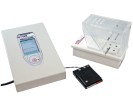Authors
Bhat V, Olmer M, Joshi S, Durden DL, Cramer TJ, Barnes RF, Ball ST, Hughes TH, Silva M, Luck JV, Moore RE, Mosnier LO, von Drygalski A
Lab
Department of Molecular and Experimental Medicine, The Scripps Research Institute, La Jolla, California.
Journal
Am J Hematol.
Abstract
Hemophilic arthropathy is a debilitating condition that can develop as a consequence of frequent joint bleeding despite adequate clotting factor replacement. The mechanisms leading to repeated spontaneous bleeding are unknown. We investigated synovial, vascular, stromal, and cartilage changes in response to a single induced hemarthrosis in the FVIII-deficient mouse. We found soft-tissue hyperproliferation with marked induction of neoangiogenesis and evolving abnormal vascular architecture. While soft-tissue changes were rapidly reversible, abnormal vascularity persisted for months and, surprisingly, was also seen in uninjured joints. Vascular changes in FVIII-deficient mice involved pronounced remodeling with expression of ?-Smooth Muscle Actin (SMA), Endoglin (CD105), and vascular endothelial growth factor, as well as alterations of joint perfusion as determined by in vivo imaging. Vascular architecture changes and pronounced expression of ?-SMA appeared unique to hemophilia, as these were not found in joint tissue obtained from mouse models of rheumatoid arthritis and osteoarthritis and from patients with the same conditions. Evidence that vascular changes in hemophilia were significantly associated with bleeding and joint deterioration was obtained prospectively by dynamic in vivo imaging with musculoskeletal ultrasound and power Doppler of 156 joints (elbows, knees, and ankles) in a cohort of 26 patients with hemophilia at baseline and during painful episodes. These observations support the hypothesis that vascular remodeling contributes significantly to bleed propagation and development of hemophilic arthropathy. Based on these findings, the development of molecular targets for angiogenesis inhibition may be considered in this disease. Am. J. Hematol., 2015. © 2015 Wiley Periodicals, Inc.
BIOSEB Instruments Used:
Static Weight Bearing Touch: Incapacitance Test (BIO-SWB-TOUCH-M)

 Douleur - Allodynie/Hyperalgésie Thermique
Douleur - Allodynie/Hyperalgésie Thermique Douleur - Spontanée - Déficit de Posture
Douleur - Spontanée - Déficit de Posture Douleur - Allodynie/Hyperalgésie Mécanique
Douleur - Allodynie/Hyperalgésie Mécanique Apprentissage/Mémoire - Attention - Addiction
Apprentissage/Mémoire - Attention - Addiction Physiologie & Recherche Respiratoire
Physiologie & Recherche Respiratoire
 Douleur
Douleur Système Nerveux Central (SNC)
Système Nerveux Central (SNC)  Neurodégénérescence
Neurodégénérescence Système sensoriel
Système sensoriel Système moteur
Système moteur Troubles de l'humeur
Troubles de l'humeur Autres pathologies
Autres pathologies Système musculaire
Système musculaire Articulations
Articulations Métabolisme
Métabolisme Thématiques transversales
Thématiques transversales SFN2024: Venez rencontrer notre équipe sur le stand 876 à Chicago
SFN2024: Venez rencontrer notre équipe sur le stand 876 à Chicago 